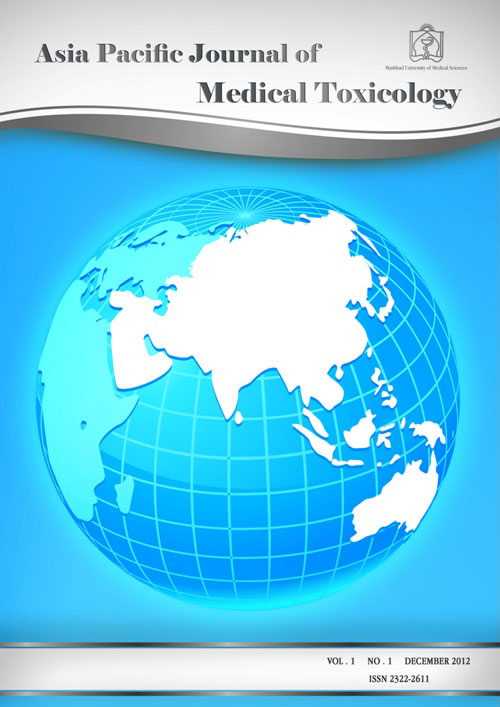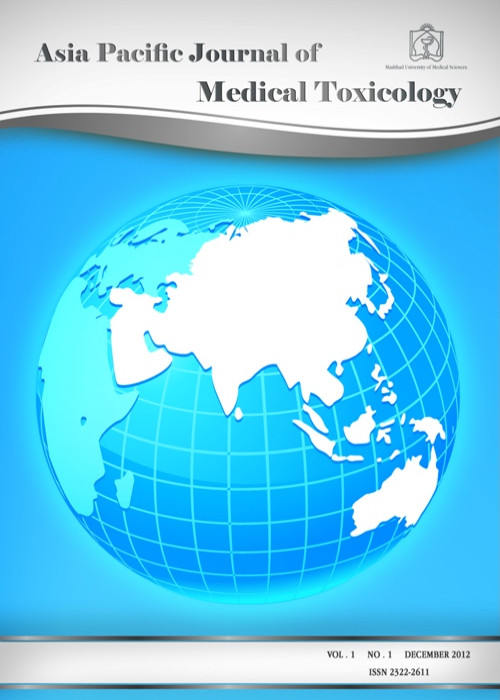فهرست مطالب

Asia Pacific Journal of Medical Toxicology
Volume:4 Issue: 4, Autumn 2015
- تاریخ انتشار: 1394/11/15
- تعداد عناوین: 9
-
-
Pages 134-138BackgroundGastroesophageal reflux disease (GERD) prevalence in patients with sulfur mustard (SM)-induced bronchiolitis obliterans (BO) is higher than exposed cases with mild lung injuries. In this study, we aimed to evaluate the prevalence of microaspirations using nuclear scintiscan among BO patients with SM exposure.MethodsThis was a prospective cross-sectional study conducted on patients with SM-induced BO and pulmonary symptom exacerbation referred to the Baqiyatallah Hospital, Tehran, Iran during the year 2009. Following the endoscopy-based diagnosis of GERD by a gastroenterologist, anti-reflux medications were withdrawn for 72 hours and then the patients underwent nuclear scintigraphy scan following 12 hour ingestion of fat containing food as radionuclide dinner. High resolution computed tomography (HRCT), spirometry and bronchoscopy were also performed for all patients.ResultsIn this study, 39 patients (94.9% men) with mean (± SD) age of 45.1 ± 6.2 years were enrolled. The most common clinical complaints of the patients were thick sputum (97.4%) and dyspepsia (94.7%), followed by chest tightness (89.7%), nocturnal cough (82.1%), and nocturnal dyspnea (66.7%). In HRCT, air-trapping was the most common pulmonary finding (92.1%). In spirometry, mean (±SD) FEV1 and FEV1/FVC were 52.7 ± 22.4% and 70.4 ± 13.9%, respectively. In bronchoscopy, the most common finding was airway remodeling (62.2%), followed by false vocal cord hypertrophy (24.3%). In scintigraphic imaging, only 1 patient had a remarkable finding, in whom, the radionuclide material was seen in the pharynx (proximal GERD), but did not produce marked microaspiration of gastric substances into the airways.ConclusionAlthough previous reports demonstrated high prevalence of GERD and microaspiration in patients with SM-induced BO, we did not find remarkable evidence for microaspiration in scintiscan in patients included in this study.Keywords: Bronchiolitis Obliterans, Gastroesophageal Reflux, Mustard Gas, Poisoning, Radionuclide Imaging
-
Pages 139-142BackgroundParaquat poisoning is a medical emergency challenge due to its inherent severe toxicity and unavailability of specific antidote for it. In this paper, a series of patients who were treated according to a commonly used treatment flowchart are presented.MethodsThis prospective observational study was carried out on paraquat poisoned patients admitted to District Hospital, Chamarajanagar and Shimoga institute of Medical Sciences, Shimoga, Karnataka, India, during January 2013 to December 2014.ResultsSix patients (4 women and 2 men) with median age of 23 [min-max: 18-42] years were studied. The majority of patients had respiratory distress (with an average SpO2 of 60%), i.e. 4 out of 6 cases manifested with respiratory distress associated with dryness and burning sensation in mouth, throat and chest. Oxygen therapy with mask in one case and by ventilator in rest of cases was required. Except one patient who died on the first day and no further measurement of serum creatinine could be taken from her, all other patients developed increased creatinine. Five out of 6 patients died mainly due to pulmonary sequels. In the only survived patient, gastrointestinal symptoms were predominant followed by acute renal failure and pulmonary congestion which were reverted with medical care indicated in the therapeutic flowchart. In post-mortem investigations, inflammatory infiltration in lungs was noted in all cases and acute tubular necrosis was seen in 3 cases.ConclusionRenal insufficiency and pulmonary damage following severe paraquat poisoning are indicators of poor prognosis and may not be reversible with commonly used treatment approaches.Keywords: Clinical Protocols, Paraquat, Poisoning, Renal Insufficiency, Respiratory Insufficiency
-
Pages 143-146BackgroundA good proportion of poisoned patients treated at poisoning wards are elderly. This study was designed to evaluate the epidemiologic pattern of acute poisoning in elderly in Hamadan, western Iran.MethodsIn this retrospective cross-sectional study, poisoned patients aged 60 years and older treated at department of poisoning of Farshchian Hospital from March 2008 to March 2013 were included.ResultsIn this 5-year period, 7951 poisoned patients were treated at Farshchian Hospital in Hamadan, Iran. Among them, 418 (5.3%) patients were 60 years old or older, with mean age of 71.6 ± 5.1 years. Narcotics and recreational substances were the most common type of poisons responsible for poisoning (46.4%), which among them, methadone was the most commonly used drug (20.3%). Neurologic medicines were the most commonly used pharmaceutical products (16%), among which, benzodiazepines (8.9%) were responsible for the highest number of poisonings due to pharmaceuticals. Fifteen patients (3.6%) including 13 men and 2 women died. The toxic agents used by cases with fatal outcome were opioids (8 patients), organophosphates (5 patients) and aluminum phosphide (2 patients). Men were found to be significantly more affected with recreational substances (P < 0.001) and pesticides (P < 0.001), while poisoning with pharmaceutical products (P = 0.017) was significantly more common in women. Regarding the intention of poisoning, accidental poisoning (P = 0.025) and overdose (P < 0.001) were significantly more common in men while deliberate self-poisoning was significantly more frequent in women (P < 0.001).ConclusionDeliberate self-harm and poisoning with opioids especially methadone showed a high prevalence in elderly poisoned patients in Hamadan, Iran. It seems that drug trafficking control, addiction rehabilitation therapies and suicide prevention programs for elderly can be helpful in poisoning reduction in this age group in this part of the country.Keywords: Aged, Iran, Methadone, Opioid, Related Disorders, Poisoning
-
Pages 147-150BackgroundCardiac failure is the major lethal consequence of aluminum phosphide (AlP) poisoning. This study was designed to determine the frequency of cardiac arrhythmias in patients with AlP poisoning.MethodsIn this prospective cross-sectional study, patients with definitive history of AlP poisoning treated at emergency department of Allied Hospital Faisalabad, Faisalabad, Pakistan, from July 2013 to November 2014 were included. On admission, twelve-lead electrocardiogram (ECG) was performed for all patients. During admission, all patients underwent continuous cardiac monitoring using a cardiac monitor. If an arrhythmia was suspected on the cardiac monitor, another ECG was obtained immediately.ResultsDuring the study period, 100 patients with AlP poisoning (63% men) were treated at Allied Hospital Faisalabad. Mean age of the patients was 26.7 ± 7.9 years ranging from 16 to 54 years. Tachycardia was detected in 68 patients and bradycardia in 12 patients. Hypotension was observed in 75 patients. Eighty patients developed cardiac arrhythmia. The most frequent arrhythmia was atrial fibrillation (31% of patients) followed by ventricular fibrillation (20%), ventricular tachycardia (17%), 3rd degree AV block (7%) and 2nd degree AV block (5%). In total, 78 patients died, depicting a 78% mortality rate following wheat pill poisoning. Among those who died, seventy-one patients had cardiac arrhythmia. Comparison of death rate between patients with and without cardiac arrhythmia showed a significant difference (71/80 (88.8%) vs. 7/20 (35%); P < 0.001).ConclusionWheat pill poisoning causes a very high mortality, and circulatory collapse is the major cause of death among these patients. Most of the patients with AlP poisoning develop cardiac arrhythmias which are invariably life threatening. Early detection of cardiac disorders and proper management of arrhythmias may reduce mortalities.Keywords: Aluminum Phosphide, Cardiac Arrhythmias, Cardiogenic Shock, Poisoning
-
Pages 151-156BackgroundDeath due to acute poisoning is of medical, legal and social significance. This study was designed to investigate lethal poisonings among dead bodies referred to a regional office of Iranian Legal Medicine Organization (ILMO).MethodsThis was a retrospective descriptive-analytical study on dead bodies referred to Fars province regional office of ILMO in Shiraz, Iran, during April 2013 to the end of March 2014. For data analysis, only subjects with poisoning as the definitive cause of death were included.ResultsDuring the study period, 2,594 autopsies were conducted in Fars province office of ILMO, among which poisoning was found to be the cause of death in 147 autopsies (5.7%). Eighty-eight cases (59.9%) were men. The majority of subjects aged 20 to 30 years (50.3%). The greatest number of subjects (73.5%) was unmarried persons. Regarding the occupation, most subjects were unemployed (49.7%) followed by housewives (19.7%). Over half of the cases (54.42%) had died within less than 6 hours after the poisoning. The majority of cases were found dead at home (73.5%), while the rest had died in outpatient department or hospital wards. Suicide cases were far more common than unintentional cases (75.5% vs. 24.5%). Suicidal intention was significantly higher in subjects with lower educational status (P = 0.033). The most common causes of poisoning were pharmaceutical products (66.7%) followed by aluminum phosphide (10.9%) and other types of pesticides (7.2%).ConclusionLethal poisonings is mostly seen in young adults, and those with lower educational level and unemployment. Suicidal intention is the main cause of lethal poisonings.Keywords: Forensic Toxicology, Iran, Mortality, Suicide, Poisoning
-
Pages 156-160BackgroundToxic exposures in childhood are major health concern. In this hospital-based study, we sought to investigate socio-epidemiological factors contributing to acute pediatric poisoning in Chennai, Tamil Nadu, India.MethodsThis prospective cross-sectional study was conducted at the Kanchi Kamakoti CHILDS Trust Hospital (KKCTH), a tertiary care hospital for children in Chennai. Children and adolescents less than 18 years of age with diagnosis of acute poisoning during June 2014 to January 2015 were included in the study.ResultsDuring the study period, 10500 children were admitted to emergency department of the hospital; among which, 34 children presented with diagnosis of acute poisoning (0.32% of admissions). Eighteen patients (52.9%) were boys. The greatest proportion of patients (52.9%) aged 1 to 3 years. Regarding the intention of poisoning, 27 cases (79.4%) occurred following unintentional ingestion by children, 5 cases (14.7%) following inadvertent administration of medication(s) by a caregiver and 2 cases (5.9%) following inadvertent administration by a sibling. Children had relatively equal chance of being poisoned with medications (n = 18, 52.9%) and common household agents (n = 16, 47.1%). The most common medicines responsible for the poisonings were neuropsychiatric medicines (n = 6, 17.6%). None of the medications responsible for poisoning had childproof containers. On admission, only 14 children (41.2%) were symptomatic. Fifteen patients (44.1%) required admission to hospital wards and 4 patients (11.8%) required intensive care. The remaining patients only needed close observation for a few hours. All children made complete recovery and there was no mortality.ConclusionChildren especially toddlers of either gender are vulnerable to unintentional exposures and need constant supervision by an adult. Educating caregivers about the fatalities associated with unprotected storage of medications, and dangers of placing hazardous chemicals in the reach of children will reduce a great number of poisoning in children.Keywords: Epidemiology, India, Pediatrics, Poisoning
-
Pages 161-164BackgroundScorpion sting envenomation generally causes treatable local and systemic effects; however, in rare cases, the victims might experience sequels in end organs such as central nervous system. In the present paper, a case of relatively self-limiting demyelinating polyneuropathy following a Butidae sting is presented and the possible mechanisms are discussed.Case PresentationA 19-year-old man presented to emergency department of Sultan Qaboos University Hospital, Oman with severe throbbing pain at the base of his right big toe after a scorpion sting. His initial examination revealed normal vital signs and the systemic examinations were unremarkable. Few minutes later, he developed profuse sweating, slurred speech, blurred vision, increased salivation and restlessness. Repetition of measurement of vital signs showed a blood pressure of 160/100 mmHg, heart rate of 140 beat per minute and a respiratory rate of 18 per minute. The patients received scorpion antivenom and cholinergic hyperactivity manifestations. Shortly after, the patient developed involuntary jerky movements in both lower associated with fasciculation. Nerve conduction study was suggestive of demyelinating polyneuropathy. In later days, involuntary jerky movements of lower limbs improved gradually but fasciculation remained. On a follow-up visit after four months, the patient still complained of occasional fasciculation.DiscussionOne explanation for the development of peripheral nerves demyelination in our patient is the inflammatory response triggered by scorpion venom. In addition, this complication can be attributed to direct cytotoxic effects of scorpion venom toxins. Antimicrobial peptides in scorpion venoms are shown to be highly toxic to human cells, which in our case might have damaged the nerve sheet.ConclusionSevere scorpion sting envenomation may lead to severe systemic effects and end organ damage. Medical toxicologists should be prepared to diagnose and treat such sequels.Keywords: Fasciculation, Myoclonus, Oman, Polyneuropathies, Scorpion Stings


